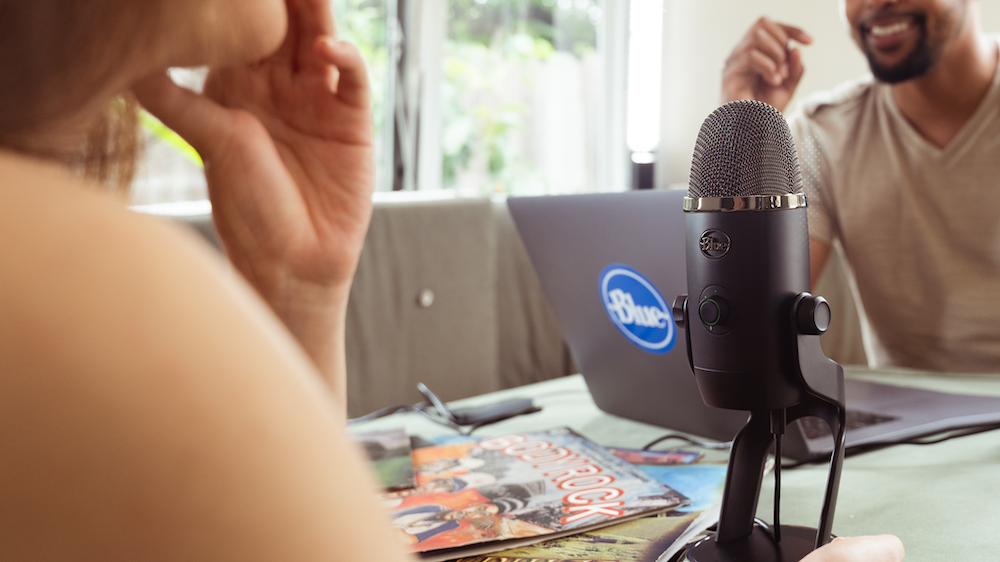Getting in the zone – how do you prepare for a podcast or livestream?

If like us you’re a podcast or livestream enthusiast, you’ve probably got a list of pet hates: the hosts who take half an hour to even start, the recordings you can barely hear, the banter that isn’t funny, the pops and booms from bad microphones and other audible irritations.
It’s all the more frustrating because the trick to making a great podcast or livestream is really simple: all you need is an interesting subject delivered with energy and enthusiasm into a good microphone.
Whether you’re showing off your speed-run skills, analysing Lil Nas X’s latest opus or solving cold cases in your true crime podcast, a few simple steps can help you establish a deeper connection with your audience. Here’s how to do it.
Find your happy place
You can podcast or stream from absolutely anywhere. While a lot of podcasts copy the radio studio format with a presenter or group all sat in front of mics that’s not the only way to do it: you can host your guests remotely, or if it’s a solo recording you can walk around with a headset mic or record as you explore the great outdoors.
What matters isn’t the location but whether or not you (and your guests) are comfortable and far from power drills, screaming sirens and other possible interruptions.
Rock the right mic
A poor quality microphone can undo all your best efforts – and a good one can bring you closer to your listeners by delivering a wonderfully clear and intimate sound.
You don’t need to spend hundreds of pounds on a studio-spec mic, though: USB microphones such as the Blue Yeti, Yeti Nano and Yeti X are popular with podcasters for their superb sound quality, practicality and price.
The advanced models are particularly great: with up to four audio pickup patterns – cardioid, omni, bidirectional, and stereo – you can use a single mic to record multiple speakers simultaneously with incredible clarity.

There’s another reason to get a Yeti: Blue VOICE software. It’s a dramatic, free upgrade for Yeti customers that’s perfect for podcasters.
Blue VOICE gives you enhanced, broadcast-quality audio effects and filters and advanced voice modulation that you can use to deliver studio-quality sound no matter where you record.
Check your levels
You know about checking your audio levels, but what about your energy levels? Our favourite podcasts are all very different but the one thing they have in common is their energy: if the host sounds like they’re bored with the subject, we’re not going to listen for very long.
Getting enough sleep, eating well and practicing self-care might not show up on an audio meter but it does make a huge difference to your delivery. It’s hard to be enthusiastic when your energy levels are crashing.
Take it easy
Take your time when you talk: it’s tempting to do a machine-gun delivery to get people’s attention, but that can actually be quite tiring to listen to.
Think of yourself as a storyteller: slow it down, take little pauses and use music or other audio to break things up where appropriate.

Blue VOICE has some great HD audio samples you can use for just that, and you can even create macros to string multiple samples together for instant activation while you record or stream.
With so many available options it’s tempting to use them all, but while that’s a lot of fun it’s important to use effects sparingly: after all, the most important sound in your podcast is you.
Know who you are
The best podcasters have a clear persona and purpose, so for example on the popular podcast You’re Wrong About presenters Michael Hobbes and Sarah Marshall are journalists obsessed with misinformation, misreporting and righting past wrongs; on How Did This Get Made? Paul Scheer, June Diane Raphael and Jason Mantzoukas are there to roast really bad films and make their listeners laugh; on Killt, true crime enthusiast Louise Blain guides her listeners to the very best true crime podcasts.
Know who you’re talking to
Podcasts that try to be everything to everyone aren’t usually very successful: the best ones are made for a particular audience and address them directly.
An individual’s podcast should feel like a call from a friend or mentor; a group one should feel as if you’re in the room with a bunch of really smart, interesting and (if appropriate) funny people.
Plan ahead
There’s incredible creative freedom to podcasting, but if you’re new to it then it’s a good idea to plan what you’re going to say in advance.
That doesn’t mean you have to write a full script, although some podcasters do, but it’s wise to use cue cards or bulleted lists to remind you of the key messages you want to get across.
Make connections
Podcasting is of course a one-way medium, but social media makes it easy for you to continue the conversation with your listeners; you might find that those conversations then influence future episodes.
Podcasts are all about shared passions, and if you connect with people they’ll want to tell you about it.
Take notes of all the positive feedback you get and forget any negativity unless it’s constructive criticism. Keeping a collection of nice comments can give you an instant confidence boost that lasts much longer than any episode.
As you can see, there's plenty to consider when starting your journey into podcasting - more than anything, however, it's important to relax and enjoy your new venture!
If you'd like to find out how Blue VOICE can help make your podcasts more engaging, more professional, and more popular, then click here.
Sign up for breaking news, reviews, opinion, top tech deals, and more.